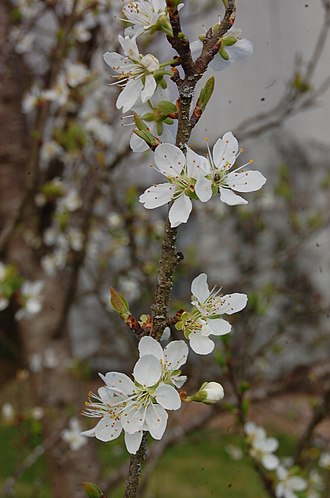Bullace
Bullace is a term that refers to a variety of wild plums from the genus Prunus. The bullace is a fruit closely related to the damson and the more commonly known plum. It is native to certain regions of Europe and Asia, thriving in temperate climates. The fruit has been part of human consumption for centuries, valued both for its culinary and potential medicinal properties.
Description
The bullace tree is a deciduous tree that can grow to a height of approximately 4-10 meters. It has a bushy appearance, with branches that spread outwards. The leaves are oval-shaped, with a serrated edge, and the flowers are white, appearing in early spring before the leaves. The fruit of the bullace is smaller than that of the common plum, with a diameter of about 2-3 cm. It has a thick skin and a firm flesh, with a sour to sweet taste depending on the variety and ripeness. The fruit is usually dark blue or purple in color, though some varieties may be yellow or green.
Cultivation
Bullace trees are hardy and can tolerate a range of soil types, though they prefer well-drained, fertile soil. They can be propagated from seed, but more commonly, they are grafted onto rootstocks to control the size of the tree and improve fruit yield. Bullace trees require minimal pruning, mainly to remove dead or diseased wood and to maintain shape. They are less susceptible to diseases that commonly affect plum trees, making them a robust choice for both commercial and home orchards.
Uses
The bullace fruit is versatile in its uses. It can be eaten fresh, though its sour taste may not be appealing to everyone. More commonly, it is used in cooking and baking, making excellent jams, jellies, and preserves due to its high pectin content. The fruit is also used in the production of wines and spirits. In traditional medicine, the bullace has been used to treat a variety of ailments, though scientific evidence supporting these uses is limited.
Culinary and Medicinal Properties
Bullace fruits are rich in vitamins, particularly Vitamin C, and antioxidants. They have been used in folk medicine to boost the immune system, improve digestion, and as a remedy for constipation. The leaves and bark of the bullace tree have also been used in traditional medicine, though their use is less common today.
Conservation and Biodiversity
The wild varieties of bullace are important for biodiversity. They provide food for a range of wildlife, including birds and insects. In some regions, the bullace is considered a heritage fruit, with efforts being made to preserve its genetic diversity through orchard plantings and seed banks.
Conclusion
The bullace is a valuable fruit with a rich history. Its cultivation and preservation contribute to biodiversity, and its uses in the kitchen and potentially in medicine highlight its versatility. As a lesser-known relative of the plum, the bullace offers an interesting opportunity for culinary exploration and garden cultivation.
Transform your life with W8MD's budget GLP-1 injections from $125.
W8MD offers a medical weight loss program to lose weight in Philadelphia. Our physician-supervised medical weight loss provides:
- Most insurances accepted or discounted self-pay rates. We will obtain insurance prior authorizations if needed.
- Generic GLP1 weight loss injections from $125 for the starting dose.
- Also offer prescription weight loss medications including Phentermine, Qsymia, Diethylpropion, Contrave etc.
NYC weight loss doctor appointments
Start your NYC weight loss journey today at our NYC medical weight loss and Philadelphia medical weight loss clinics.
- Call 718-946-5500 to lose weight in NYC or for medical weight loss in Philadelphia 215-676-2334.
- Tags:NYC medical weight loss, Philadelphia lose weight Zepbound NYC, Budget GLP1 weight loss injections, Wegovy Philadelphia, Wegovy NYC, Philadelphia medical weight loss, Brookly weight loss and Wegovy NYC
|
WikiMD's Wellness Encyclopedia |
| Let Food Be Thy Medicine Medicine Thy Food - Hippocrates |
Medical Disclaimer: WikiMD is not a substitute for professional medical advice. The information on WikiMD is provided as an information resource only, may be incorrect, outdated or misleading, and is not to be used or relied on for any diagnostic or treatment purposes. Please consult your health care provider before making any healthcare decisions or for guidance about a specific medical condition. WikiMD expressly disclaims responsibility, and shall have no liability, for any damages, loss, injury, or liability whatsoever suffered as a result of your reliance on the information contained in this site. By visiting this site you agree to the foregoing terms and conditions, which may from time to time be changed or supplemented by WikiMD. If you do not agree to the foregoing terms and conditions, you should not enter or use this site. See full disclaimer.
Credits:Most images are courtesy of Wikimedia commons, and templates, categories Wikipedia, licensed under CC BY SA or similar.
Translate this page: - East Asian
中文,
日本,
한국어,
South Asian
हिन्दी,
தமிழ்,
తెలుగు,
Urdu,
ಕನ್ನಡ,
Southeast Asian
Indonesian,
Vietnamese,
Thai,
မြန်မာဘာသာ,
বাংলা
European
español,
Deutsch,
français,
Greek,
português do Brasil,
polski,
română,
русский,
Nederlands,
norsk,
svenska,
suomi,
Italian
Middle Eastern & African
عربى,
Turkish,
Persian,
Hebrew,
Afrikaans,
isiZulu,
Kiswahili,
Other
Bulgarian,
Hungarian,
Czech,
Swedish,
മലയാളം,
मराठी,
ਪੰਜਾਬੀ,
ગુજરાતી,
Portuguese,
Ukrainian
Contributors: Prab R. Tumpati, MD


